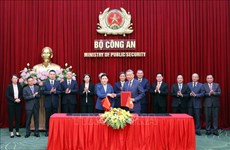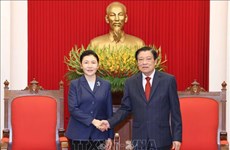Ceremony marks 40 years since Buon Ma Thuot Victory
A ceremony was held in Dak Lak on
Mar. 10 to mark the 40th anniversary of Buon Ma Thuot Victory.
A ceremony was held in the Central Highlands province of Dak Lak on
March 10 to mark the 40th anniversary of the Buon Ma Thuot Victory
(March 10, 1975), which heralded the General Offensive and Uprising in
the Spring of 1975 that led to the complete liberation of South Vietnam
and the country’s reunification.
In October 1974, the Political Bureau gathered and resolved to liberate the South between 1975 and 1976. The Tay Nguyen (Central Highlands) region was chosen as the key target for the first year of offensives.
From December 18, 1974, to January 8, 1975, the Politburo convened another meeting to evaluate the enemy situation in the South. They planned to free the South within 1975 if opportunities presented themselves.
Meanwhile, the Politburo and the Party Central Committee’s Military Commission chose Buon Ma Thuot, what is now the capital city of Dak Lak province, as the key attack point for the Tay Nguyen campaign in 1975.
Buon Ma Thuot’s position as the primary battlefield was strategically important given its proximity to Roads 14 and 21, a favourable route for attacking other provinces in the Central Highlands and central coastal and southern regions. The township’s location in the southern Central Highlands was also a substantial distance from major military centres, which would limit the enemy’s support for its forces there.
To prepare for the surprise attack in Buon Ma Thuot, Vietnam’s regular soldiers in the Central Highlands created a diversion to draw the enemy’s focus to the north of the region.
At 2:03 am on March 10, 1975, Vietnamese troops attacked Buon Ma Thuot from multiple directions. By 10 am the next day, Vietnamese soldiers had captured the Governor of Dak Lak province and had complete control of the township.
The Buon Ma Thuot Victory went down in history as one of the most resounding triumphs during Vietnam’s resistance war against the US. The Tay Nguyen campaign concluded on April 3, leading to the Politburo’s determination to free the South within 1975.
In the four decades since the battle, Buon Ma Thuot has enjoyed significant progress across sectors. It saw an average economic growth rate of 14.5 percent between 2011 and 2013 and a per capita income of 45.2 million VND (2,150 USD) annually, expected to grow to 50 million VND (2,380 USD) in 2015.
It is known for its coffee production and as one of the greenest cities in Vietnam.-VNA
In October 1974, the Political Bureau gathered and resolved to liberate the South between 1975 and 1976. The Tay Nguyen (Central Highlands) region was chosen as the key target for the first year of offensives.
From December 18, 1974, to January 8, 1975, the Politburo convened another meeting to evaluate the enemy situation in the South. They planned to free the South within 1975 if opportunities presented themselves.
Meanwhile, the Politburo and the Party Central Committee’s Military Commission chose Buon Ma Thuot, what is now the capital city of Dak Lak province, as the key attack point for the Tay Nguyen campaign in 1975.
Buon Ma Thuot’s position as the primary battlefield was strategically important given its proximity to Roads 14 and 21, a favourable route for attacking other provinces in the Central Highlands and central coastal and southern regions. The township’s location in the southern Central Highlands was also a substantial distance from major military centres, which would limit the enemy’s support for its forces there.
To prepare for the surprise attack in Buon Ma Thuot, Vietnam’s regular soldiers in the Central Highlands created a diversion to draw the enemy’s focus to the north of the region.
At 2:03 am on March 10, 1975, Vietnamese troops attacked Buon Ma Thuot from multiple directions. By 10 am the next day, Vietnamese soldiers had captured the Governor of Dak Lak province and had complete control of the township.
The Buon Ma Thuot Victory went down in history as one of the most resounding triumphs during Vietnam’s resistance war against the US. The Tay Nguyen campaign concluded on April 3, leading to the Politburo’s determination to free the South within 1975.
In the four decades since the battle, Buon Ma Thuot has enjoyed significant progress across sectors. It saw an average economic growth rate of 14.5 percent between 2011 and 2013 and a per capita income of 45.2 million VND (2,150 USD) annually, expected to grow to 50 million VND (2,380 USD) in 2015.
It is known for its coffee production and as one of the greenest cities in Vietnam.-VNA













